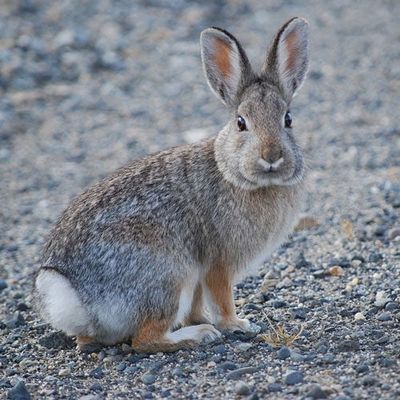Cool critters: Here comes Washington’s cottontails, hopping down the bunny trail

Happy Easter, little cottontail.
Two cottontail rabbit species go hippity hop in Washington state: the eastern cottontail and Nuttall’s cottontail, according to the Washington Department of Fish and Wildlife.
The eastern is the most common species, not only in our region but throughout North America. With its white puffball tail, big button-like eyes and pert ears, it is so cute that Beatrix Potter modeled Peter Rabbit after it in her famous children’s book.
As for Bugs Bunny? He’s cute but not a cottontail – in fact, not even a rabbit. Judging by his very long ears and legs, he’s probably a hare. But that’s a rabbit hole we’ll go down in another column.
Lucky for us, the eastern cottontail is cute, because the species “is far and away the one most likely to be seen in urban areas,” according to wildlife biologist and rabbit expert Aaron Wirsing of the University of Washington.
So whether you see a rabbit scampering across a residential street, nibbling on tulips and clover or thumping its big hind feet on your lawn, it’s probably the eastern variety. While these bunnies can be a nuisance, at least they’re little fluffs with cotton-ball tails and not naked mole rats.
As you might have guessed from its common name, the eastern cottontail is native to the Eastern United States and not the West. Why, then, do so many live here?
They were brought to Washington about a century ago as a game species to hunt for food, Wirsing said, adding that the rabbits adapted exceedingly well to human-populated areas, along with those that are semi-arid and brushy.
In contrast, the Nuttall’s cottontail is native to the state and a “creature of the sagebrush” not generally seen in urban areas, he said.
How to tell a Nuttall’s cottontail from an eastern if you live on the outskirts of sage-brushy areas like Yakima or Wenatchee?
The most obvious difference is the more pronounced white tail of the eastern cottontail, Wirsing stated. Also, “Nuttall’s has a distinctive cinnamon-colored ring around each eye” and is slightly smaller than the eastern cottontail, Wirsing said.
And another thing – the diet of the Nuttall’s cottontail makes it unique among plant-eating animals.
“This species can eat sagebrush and juniper berries, which are notoriously unpalatable to most herbivores,” Wirsing said.
Like all rabbits, our cottontail species detect sounds from long distances by swiveling and tilting their large ears.
Moving each ear independently like a radar dish, they can pinpoint noises coming from different directions at the same time, according to the National Parks Service website.
When pursued by a hunter – ranging from owls, hawks and raccoons to snakes, dogs and humans – the cottontail will run in a zig-zag pattern to throw the predator off track, the agency states.
Cottontails generally have short lifespans in the wild, rarely exceeding two or three years. In fact, many are killed by wild predators within a month of being born, according to research. Consequently, they’ve evolved to become reproduction machines, often delivering two to four litters each season.
Since breeding season begins in March, you’ll be seeing more brown, white-tailed bunnies come summer.
Let’s hope they won’t be domestic rabbits that were given as Easter pets. While bunnies may seem like a good holiday gift, each year they are released outdoors “when people lose interest in them, move, feel the animal is too messy, or when it is no longer cute and cuddly,” according to the WDFW.
The problem is, domestic rabbits don’t do well on their own. They have trouble finding food and aren’t equipped to avoid predators, the agency states. What’s more, they dash across roads, burrow in people’s yards, eat garden carrots and more.
So this Easter and always, it’s probably best to enjoy the wild cottontail bunnies that hop into our daily lives and to keep Flopsy and Mopsy indoors.